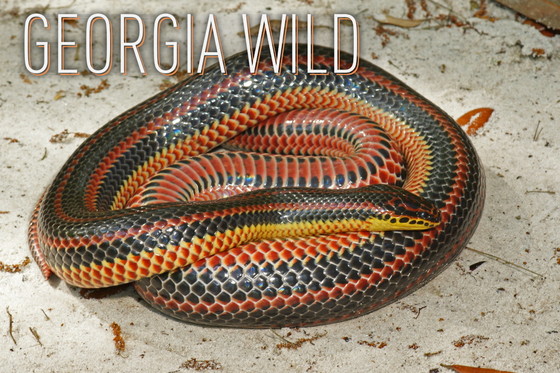 IN THIS ISSUE
- Lost plant found
- Nesting barn swallows
- Secret snakes: rainbows and muds
- New teachers guide explores sandhills
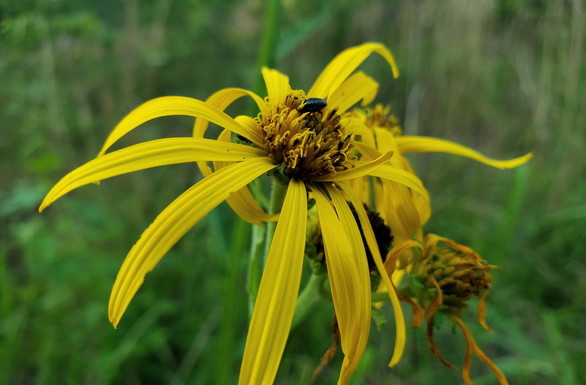 Verbesina helianthoides -- aka hairy wingstem gravelweed or yellow crownbeard (Joyce Klaus)
By JOYCE KLAUS
On a May day in 2018, my husband and I were driving around in our VW Thing doing what we like to call roadside botanizing – cruising for plants. We were on Piedmont National Wildlife Refuge in Jones County where I was providing seasonal help for prescribed burns and wanted to see the results from recent fires.
Little did I know there was a surprise in store: the rediscovery of a plant last seen in Georgia in 1991!
Like a lot of discoveries, this one was waiting in plain sight for the right person. Easing along at 5 mph, the car doors off for a better view of interesting plants, I was lucky enough to be that person.
Tall, showy yellow flowers came into view, a sight more common in the fall in Georgia. My mind ran through possible species. I jumped out as the VW sputtered to a standstill and could easily see by the wings on the stems that these beauties were in the genus Verbesina. I quickly identified the plants as Verbesina helianthoides.
There were probably thousands.
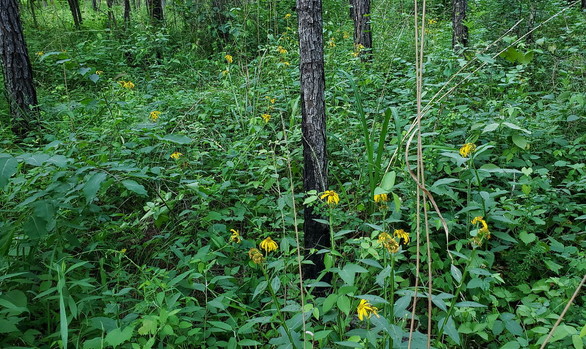 The plants at Piedmont NWR (Joyce Klaus)
Called hairy wingstem, gravelweed and even yellow crownbeard, this plant is known in Georgia only from Bibb County and had been presumed extirpated in the state, a status verified by DNR botanist Lisa Kruse. Yet Verbesina helianthoides is common in the Midwest and considered a characteristic “prairie plant.”
As with many discoveries, this one raises more questions than it provides answers. Is it evidence that Georgia’s native ecosystems historically were more like grasslands and that good management, including prescribed fire, can help bring back lost species? Or does it show how people can move species around, changing the composition and sometimes even the structure and function of ecosystems?
Maybe you know something about the history and distribution of this plant in Georgia, details that can help scientists understand it better and help answer some of these questions. If so, you can provide that information to the Facebook group Flora of the Southeastern United States or to DNR’s Lisa Kruse (email).
Dr. Joyce Klaus is owner and chief scientist at the conservation services firm Terra-Ignea Enterprises.
Top
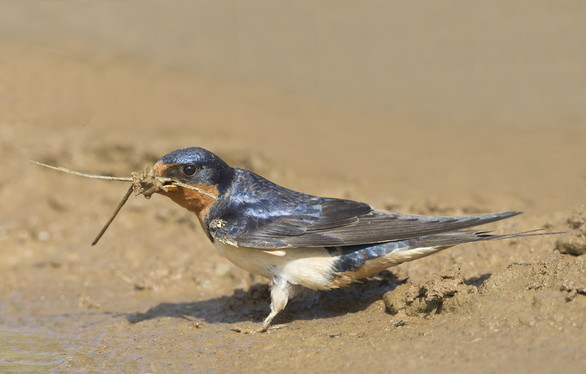 A barn swallow gathers nest material in Bibb County. (Ty Ivey/Georgia Nature Photographers Association)
By TERRY W. JOHNSON
Each year countless birds nest close to our homes. However, none offer a better chance to watch their nesting behavior than barn swallows.
These popular birds have the most expansive breeding range of all swallows, breeding across much of North America, Europe and Asia. And over countless generations, they have developed an affinity for living close to humans. In eastern North America, barn swallows' propensity for nesting on manmade structures is so strong they rarely nest anywhere else.
If a pair nests on your home or outbuilding, you will have an unobstructed view of the entire effort, from building a nest to fledging the young. If you want insights into what you’re seeing, or simply want to learn more about barn swallows, the following guide will help. …
Read the rest of Terry’s column for a close look at nesting barn swallows.
Terry W. Johnson is a retired DNR program manager and executive director of TERN, the Wildlife Conservation Section’s friends group. Check out past columns, his Backyard Wildlife Connection blog and his book “A Journey of Discovery: Monroe County Outdoors.” (Permission is required to reprint this column.)
Top
 A rainbow snake snags an eel at a boat ramp near Darien. (Tim Keyes/DNR)
By DIRK J. STEVENSON
As dusk gathers a large blue-black snake, dark as the water flowing over her, rearranges her coils among the roots of a giant cypress. Current swirls around the trunk as fluttery treefrog whistles fill the air.
The snake waits. The water moves. She straightens her muscular body, striped vivid red, and swims slowly. She rises. Breathes. Waits. Her tongue flicks, tasting the water, finding molecules of eel.
A final breath and she swims with grace along the bottom and into deeper water. The hunt is on. …
Farancia is the genus for rainbow and mud snakes – arguably among North America’s prettiest, oddest and hardest to find snakes.
From their experiences in the Okefenokee Swamp a century ago, zoologists Albert H. Wright and W.D. Funkhouser nominated cypress snake and sphagnum snake as common names, ominously describing what we now call mud snakes as “inhabitants of the twilight parts of the swamp … (found) in the dark, gloomy cypress ponds on the islands … or amongst dense vegetation of the deepest and most inaccessible regions.”
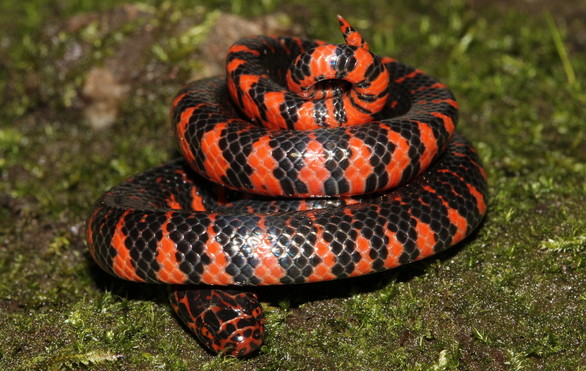 Hatchling mud snake in Wayne County (Kevin M. Enge)
Read about these fascinating snakes in Dirk's post on Georgia Wildlife Blog.
For more, check out this look at rainbows by Andrew M. Durso.
Dirk J. Stevenson is a naturalist and owner of Altamaha Environmental Consulting in Hinesville.
Top
 Sandhill rosemary in sandhills habitat (Linda May/DNR)
The sandhills of Georgia’s Coastal Plain are home to scores of rare plant and animal species, from gopher tortoises to hooded pitcherplants.
Now there’s a handbook for educators to explore sandhill habitats and wildlife with their students.
Released this week by DNR and partners, the Teacher Guide to Georgia Sandhills digs into the diversity of these land-locked dune habitats, remnants of ancient coastlines and wind-scoured river bottoms.
While lessons are geared for third and fourth grades, they can be modified for other grades and settings. Several activities are also suited for distance learning, said DNR project coordinator Linda May.
“Although Georgia’s sandhill habitats may at first seem dry and desolate, they’re really hot spots for biodiversity. Educators can play a key role in increasing awareness of and fostering appreciation for sandhills and the amazing life there.”
Sponsored by TERN, the friends group for DNR’s Wildlife Conservation Section, and the Walmart Foundation, the guide was developed by DNR biologists and interpretive staff, as well as educators.
iNATURALIST PRIMER
What are those weeds in my garden? How about that odd-looking mushroom in the woods? These and other questions can be answered fast via iNaturalist. Read along as DNR’s Anna Yellin gives an overview of the popular app.
GET INVOLVED
You probably know that DNR’s Wildlife Conservation Section is charged with conserving animals not legally fished for or hunted, as well as rare plants and natural habitats. But did you know this work is funded mostly through fundraisers, grants and contributions? Help native wildlife thrive: Buy or renew an eagle, monarch or hummingbird license plate, or donate to the cause online!
Top
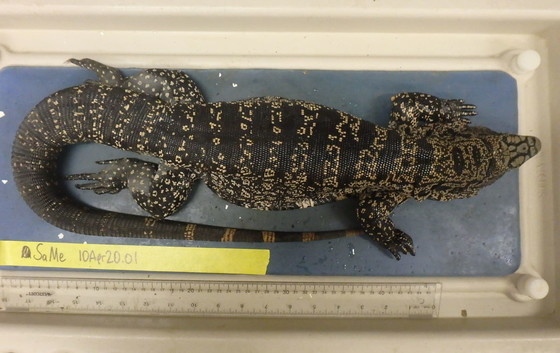 Tegu from Tattnall County (Lance McBrayer/Georgia Southern University)
Argentine black and white tegus in south Georgia’s Toombs and Tattnall counties are back in the news (including on The Weather Channel), and still in the crosshairs of a project to assess and remove these invasive reptiles from the wild. Five have been collected so far this year.
DNR’s acoustic bat monitoring program needs a few more volunteers to help run routes in June or July. Learn about the program and find available routes.
Sea turtle nesting is in full swing, with all barrier islands reporting nests, according to the Georgia Sea Turtle Cooperative. The daily count topped 430 nests this week, almost all by loggerheads and easily topping a nine-year average for May (337), though shy of the 783 nests logged this month during the record 2019 season.
Rare plant surveys in northwest Georgia turned up new information for wild bleeding heart, a Southern Appalachian endemic threatened by over-harvesting, and a high-elevation occurrence of Virginia blue-bells, a species imperiled in the state.
 Poster artwork from a kindergartener in Fayetteville (Audrey Stadler/State Botanical Garden of Georgia)
Despite the shift to remote learning during the pandemic, nearly 540 kindergarten through fifth-grade students submitted artwork in the 30th annual Give Wildlife a Chance Poster Contest. DNR and the State Botanical Garden of Georgia announced 12 statewide winners this week (see the top entries).
The 2020 North Georgia Prescribed Fire Council meeting is going virtual. The council switched to Zoom and rescheduled the session, which will address prescribed fire issues, for June 4 because of coronavirus concerns (register here).
Many human-bear encounters involve food and could be avoided by becoming BearWise, says state bear biologist Adam Hammond. “One of the six BearWise Basics is securing food, garbage and recycling. When bears have access to human-provided foods … they will take advantage of them, and that often leads to further problems.”
Interested in the proposed national park and preserve along the Ocmulgee River between Macon and Hawkinsville? The SaportaReport featured this update from the Georgia Conservancy, and here’s backgrounder from the Ocmulgee National Park and Preserve Initiative.
Top
 Summer camper at Charlie Elliott Wildlife Center (DNR)
Spaces are filling fast for summer camps at Charlie Elliott Wildlife Center near Mansfield. Fishing Day camps scheduled for June and July at the Go Fish Education Center in Perry are already on a wait-list status.
At least one of five manatees found dead in recent weeks was fatally injured by a watercraft strike, according to necropsies done by DNR. The cause of death for the other manatees – two in the Satilla River, two in the Mackay River near St. Simons Island and one in a creek near Waverly – could not be determined.
Some trailheads and access points to the Appalachian National Scenic Trail reopened May 22, including on the Chattahoochee National Forest. The U.S. Forest Service is urging responsible use, including maintaining a 6-foot distance from others, especially when passing other hikers. For more on responsible recreation outdoors, visit this website and follow #ResponsibleRecreation.
Three hurricanes in recent years – Matthew (2016), Irma (2017) and Michael (2018) – might be a memory for many, but DNR is still dealing with the damage caused in south Georgia. Work to restore habitats and rebuild infrastructure, such as repairing dikes on the coast, will take two to three more years, while the return of old-growth pine savanna ravaged in southwest Georgia will require decades.
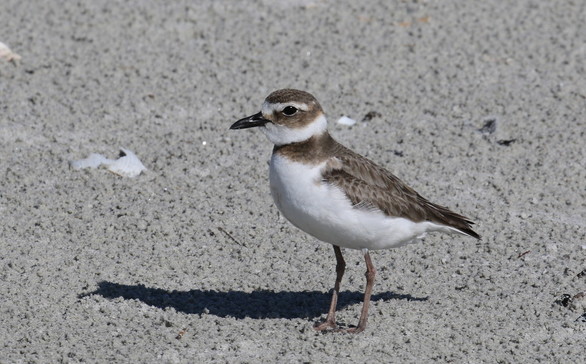 Wilson's plover (Tim Keyes/DNR)
Wilson’s plover chicks have hatched and least terns are laying eggs near Gould’s Inlet on St. Simons Island’s East Beach, the Georgia Shorebird Alliance reports. Volunteers in a DNR-led Beach Stewards Program are advising beach-goers to steer clear of the area and admire the birds from a distance.
Found a young bird? Here’s a handy guide from Mass Audubon to determine if it’s a hatchling, nestling or fledgling, and what you should do – if anything.
Millions of Americans responded to the pandemic by going fishing. Almost “every Southern state reports more anglers,” according to this blog post by the U.S. Fish and Wildlife Service’s Dan Chapman.
Names in the news: DNR game warden Ryan Locke, assigned to boating safety on Lake Lanier, received the North American Wildlife Enforcement Officers Association’s 2019 Torch Award. In 2016, DNR helped Michael Moore of the Woods Hole Oceanographic Institution collect drone images of North Atlantic right whale mom and calf pairs, images used in research released this year that documented right whales “in much poorer body condition than their counterparts in the southern hemisphere.” The Georgia Forestry Foundation newsletter featured prescribed fire mascot Burner Bob, including Bob’s video with Shan Cammack of the DNR Wildlife Conservation Section.
WHAT YOU MISSED ...
In the previous Georgia Wild:
- Welcoming whip-poor-wills
- Plant for pollinators
- Right whale season in review
- Help DNR monitor bats
Top
Tegus in Georgia coverage included New York Times, FOX News, USA Today, WMAZ-TV (Ch. 13, Macon), WSB-TV (Ch. 2, Atlanta), Insider and others.
"Help count Georgia bats for science," Georgia Public Broadcasting
"Sea turtle nesting season underway," WSAV-TV (Ch. 3, Savannah)
"Boaters be on lookout for sea turtles, manatees," Coastal Courier
"Pandemic rules make saving right whales tougher, researchers say," Bloomberg Law. More on right whales: "Endangered whales disturbingly thin" (National Geographic), "Right whales return," Canadian Broadcasting Corp.
(+audio) "Studying nature during the pandemic" (includes DNR's Jacob Thompson), WABE-FM (90.1, Atlanta)
"Fire on Little Tybee will help shorebird habitat," Augusta Chronicle
(+video) "No, probably not 'murder' hornet you're seeing," WXIA-TV (Ch. 11, Atlanta)
"Biologist shares experience with now extinct Bachman’s warbler," Savannah Morning News. Also: "Chase a rare songster of the swamp."
"Proposed mine next to Okefenokee raises alarms," Audubon
Top
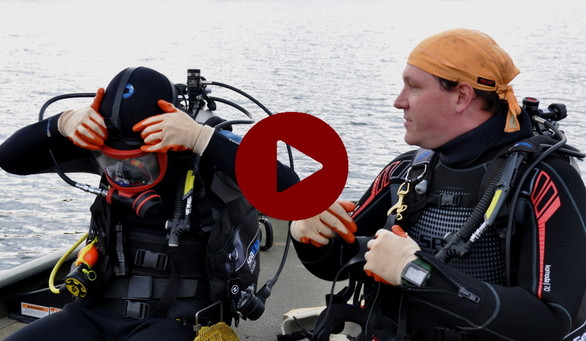 "Mussels: more than just a shell in the mud" blog post and video by DNR's Denise Shepherd
"The hidden world of river mussels," Freshwaters Illustrated
"Savannah osprey chicks growing up," Landings Bird Cam
"Barred owl in the Okefenokee," DNR State Parks
Top
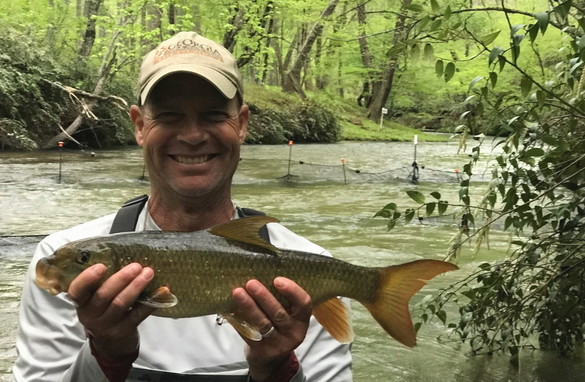 Sicklefin redhorse on Brasstown Creek (DNR)
DNR’s Peter Dimmick shows a sicklefin redhorse sampled this spring in north Georgia. Surveys done using fyke nets and deploying antennas that record tagged fish are helping scientists estimate the population size and annual survival of these state-protected suckers, found in Georgia only in a stretch of Brasstown Creek. Watch this video of sicklefin in a fyke net. Read about regional efforts to conserve this species.
CREDITS
Masthead: adult female rainbow snake on Ohoopee River (Kevin M. Stohlgren)
Top
|